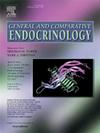芦笋素调节硬骨鱼雌性生殖功能的体外研究
IF 1.7
3区 医学
Q3 ENDOCRINOLOGY & METABOLISM
引用次数: 0
摘要
Asprosin调节哺乳动物生理的各个方面,包括生殖。据报道,它深刻影响男性和女性的生殖功能,包括配子体发生和甾体发生。Asprosin是由fbn1基因编码的原纤维蛋白的裂解产物。本小组首次在非哺乳动物脊椎动物中证实了fbn1的普遍表达,并在斑点蛇头(ss)硬骨鱼(Channa punctata)中鉴定了asprosin蛋白。基于fbn1基因的显著表达以及fbn1在马斑弓形虫卵巢中生殖期依赖的时间表达,我们假设asprosin在雌性生殖中的调节作用类似于在哺乳动物中的报道。体外实验证实了芦笋素对马斑弓形虫卵生成和甾体生成的影响。Asprosin显著提高了pcna和gdf9等卵发生关键基因的表达。它还增加了促性腺激素受体和性类固醇受体基因的转录。此外,asprosin增强了甾体生成标志物如star和cyp17a1的表达以及17α, 20β二羟基孕酮的水平。我们还测量了暴露于asprosin的卵巢中第二信使cAMP的水平,以探索gpcr作为asprosin受体的可能性。然而,asprosin不能改变cAMP的水平,这表明在硬骨鱼卵巢中,可能有gpcr以外的受体参与了asprosin的转导作用。因此,本研究阐明了asprosin在针叶锦鸡卵巢功能调节中的重要作用。本文章由计算机程序翻译,如有差异,请以英文原文为准。

Asprosin modulates female reproductive functions in teleosts: An in vitro study in Channa punctata
Asprosin regulates various aspects of physiology in mammals including reproduction. It is reported to profoundly affect both male and female reproductive functions including gametogenesis and steroidogenesis. Asprosin is the cleaved product of a profibrillin protein encoded by the fbn1 gene. For the first time in non-mammalian vertebrates, our group demonstrated the ubiquitous expression of fbn1 and characterized asprosin protein in silico in teleost Channa punctata commonly known as spotted snakehead (ss). Based on the prominent expression of the fbn1 gene and the reproductive phase-dependent temporal expression of fbn1 in the ovary of C. punctata, we hypothesized the regulatory role of asprosin in female reproduction similar to that reported in mammals. In vitro studies confirmed the effect of asprosin on the oogenesis and steroidogenesis in C. punctata. Asprosin significantly enhanced the expression of genes crucial for oogenesis such as pcna and gdf9. It also increased the transcription of gonadotropin receptors and sex steroid receptor genes. In addition to this, asprosin accentuated the expression of steroidogenic markers such as star and cyp17a1 along with 17α, 20β dihydroxy-progesterone levels. We also measured the levels of the second messenger cAMP in ovaries exposed to asprosin to explore the probability of GPCRs as asprosin receptors. However, asprosin could not alter the cAMP levels indicating that, in the ovary of teleosts, receptors other than GPCRs might be involved in transducing asprosin action. Thus, the present study in elucidates the important role of asprosin in modulating the ovarian functions in C. punctata.
求助全文
通过发布文献求助,成功后即可免费获取论文全文。
去求助
来源期刊

General and comparative endocrinology
医学-内分泌学与代谢
CiteScore
5.60
自引率
7.40%
发文量
120
审稿时长
2 months
期刊介绍:
General and Comparative Endocrinology publishes articles concerned with the many complexities of vertebrate and invertebrate endocrine systems at the sub-molecular, molecular, cellular and organismal levels of analysis.
 求助内容:
求助内容: 应助结果提醒方式:
应助结果提醒方式:


